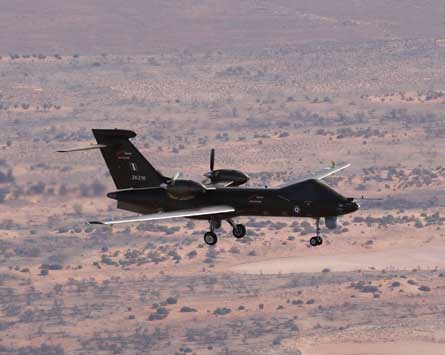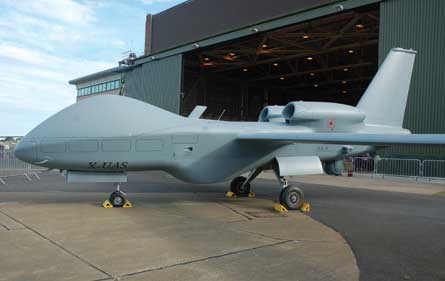Two years ago, the idea of France's largest defence contractor joining forces with its UK equivalent on a bilateral aerospace project would have been almost unthinkable, but a global economic crisis and political will have led to the creation of just such a pact between Dassault and BAE Systems.
To be in evidence at Le Bourget for the first time since French President Nicolas Sarkozy and UK Prime Minister David Cameron signed a cross-channel defence treaty late last year, the surprise co-operation includes the planned provision of a medium-altitude, long-endurance (MALE) unmanned air system. If the allies' plans hold firm, the type could be in frontline use with their armed forces as soon as 2015-20.
With objectives including sharing the costs of military-themed research and development, procurement, logistics support and some operations, the coming together has been driven not by industrial desire, but financial necessity. Describing the initiative as "practical, hard-headed co-operation between sovereign countries", Cameron last November said the treaty will "help us to maintain and strengthen our defences at a time when national finances are severely challenged".
JOINT TEAM
Dassault and BAE over the ensuing months looked beyond their traditional rivalry and into the possibility of jointly creating a next-generation unmanned system capable of performing persistent surveillance tasks. Progress was fast, and in February they signed an exclusive memorandum of understanding to work as a joint team. "We wanted to publicise the fact that we were in this together and that we were serious about taking this forward," says Ian Fairclough, BAE's programme director for strategic UAS.
"That decision to partner didn't happen by chance, and it wasn't a decision that both parties took lightly. We felt that we had a really compatible set of experience that had been developed nationally and that we would get huge benefit by combining that into a single industry team."
 |
|---|
© BAE Systems |
BAE's Mantis demonstrator has provided the basis for a bilateral feasibility study into an operational system to enter use after 2015 |
Conscious of the financial benefits of a collaborative venture, the UK Ministry of Defence had in 2009 begun to explore options for a bilateral European UAS programme. This was advanced last year to a feasibility study also involving France's DGA procurement agency, BAE and Dassault.
The process sought to compare the nations' individual requirements for a MALE system and balance these against demonstration work already performed by the intended partner companies. It also assessed the likely cost and schedule of a joint programme, plus manufacturing and final assembly considerations.
"We looked at the industrial aspects in terms of how UK and French industry could work together to deliver this, what sort of workshare arrangements we might have and how we would work out the supply chain," says Fairclough. "The conclusion was that a UK/French programme was something that was feasible, and something that industry could easily co-operate on. We also found that we could deliver a solution within the timescale and cost parameters."
Although it is still early days in the partners' journey towards introducing the planned OUAS capability, the collaboration between what have traditionally been fierce rivals is unprecedented. It also comes at a time when they are facing up to one other in a $10 billion-plus dogfight to meet the Indian air force's 126-unit medium multirole combat aircraft requirement. Dassault is offering its "omnirole" Rafale against the Typhoon produced by Eurofighter consortium partners Alenia Aeronautica, BAE and EADS.
Despite this clash, the partners will signal their new collaboration at the show by exhibiting a representative model of the proposed OUAS on Dassault's stand. This will be based heavily on BAE's Mantis Spiral 1 vehicle, which was flown for the first time in October 2009 under a technology demonstration programme for the UK MoD.
"On the feasibility study we started from a hypothesis that was based on the Mantis for the air vehicle side," says Yves Robins, an adviser to Dassault executive vice-president Eric Trappier. "All the experience from the Mantis will be used."
Developed within 19 months and flown at the Woomera test range in South Australia, Mantis demonstrated aspects including rapid prototyping, ground control and mission system equipment, sensors and autonomy.
"The challenge was to design, develop, build and then put into flight trials a prototype vehicle aimed at developing a suite of capabilities in the UK," Fairclough says. "We successfully proved that we have the capability within Europe to develop this class of vehicle." Partners on the programme included GE Aviation, Meggitt, Qinetiq, Rolls-Royce and Selex Galileo.
The success with the R-R RB250B-17-turboprop-engined Mantis followed BAE's previous work with unmanned systems including the Corax, Herti and Raven. With its flight campaign completed, the more than 20m (65.6ft) wing span aircraft is parked up at the company's Warton site in Lancashire, and is not scheduled to be flown again.
 |
|---|
© Craig Hoyle/Flightglobal |
EADS could offer an X-UAS version of its Talarion if a competitive process is pursued |
Dassault also has valuable past experience, having flown the AVE-D demonstrator and investigated a previous SDM MALE concept for France. It is now leading Europe's Neuron unmanned combat air system demonstration programme, which should achieve first flight with the stealthy type during 2012.
"We are happy to be able to work with BAE," says Robins, "and for this project we are happy to see them having the lead." The partners on 8 June announced that the collaborative venture will be named Telemos.
The jointly funded OUAS project is now in its assessment phase while the defence ministries work towards issuing a formal requirement within the next few months. A joint programme office has been formed at the MoD's Abbey Wood site in Bristol, England.
SURVEILLANCE TASKS
Although primarily intended for persistent surveillance tasks, the aircraft could have wider uses. "It's not just about going out and seeing things, it's potentially about targeting and deploying weapons as well," says BAE.
Fairclough says a variety of programme options are being considered, but that while the nations have expressed their desire to proceed with a direct procurement, European competition law could thwart such a strategy. If a contest is conducted, this could be of interest to EADS company Cassidian, which is trying to launch its Talarion programme. A version of the turbofan-powered design has previously been touted to the UK as the "X-UAS".
"The UK and French governments have invested heavily in developing capability in unmanned systems around BAE and Dassault. Getting the programme launched early will help us sustain that capability within industry," says Fairclough. "The sooner we get started the lower the risk of delivering that capability and the more maturity we can get into the product. We believe we're ready to start the programme now.
"We've got real flight trials information on a representative MALE vehicle, so we're really well positioned to come up with a concept that's going to work very quickly."
The prospect of building probably only tens of OUAS platforms for the two nations places the transition in scale from the manned fighter business to unmanned activities into clear focus. The UK has recently estimated the purchase and through-life support costs of its future MALE system at around £2 billion ($3.27 billion). But if advanced, the link between Dassault and BAE could lead to further collaboration beyond their respective Neuron and Taranis technology demonstrations, as their main customers look towards acquiring unmanned combat platforms to enter use from around 2030.
"If we can get this [OUAS] programme off the ground on a UK/French basis, it certainly gives us options and opportunities to look at how you might evolve that into a UCAS programme in the future," says Fairclough.
Such a development would represent a generational advance over the companies' experience in the fighter sector. After all, their current rivalry in India's MMRCA contest would never have happened had they not gone their separate ways in developing the Eurofighter and Rafale after a once joint set of requirements drifted dramatically apart.
See more coverage on the unmanned air systems sector
Source: Flight International























